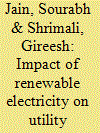| Srl | Item |
| 1 |
ID:
112259


|
|
|
|
|
| Publication |
2012.
|
| Summary/Abstract |
The objective of this paper is to analyze the effect on utility finances and consumer tariffs of implementing utility-funded demand-side energy efficiency (EE) programs in India. We use the state of Delhi as a case study. We estimate that by 2015, the electric utilities in Delhi can potentially save nearly 14% of total sales. We examine the impacts on utility finances and consumer tariffs by developing scenarios that account for variations in the following factors: (a) incentive mechanisms for mitigating the financial risk of utilities, (b) whether utilities fund the EE programs only partially, (c) whether utilities sell the conserved electricity into spot markets and (d) the level of power shortages utilities are facing. We find that average consumer tariff would increase by 2.2% although consumers participating in EE programs benefit from reduction in their electricity consumption. While utility incentive mechanisms can mitigate utilities' risk of losing long-run returns, they cannot address the risk of consistently negative cash flow. In case of power shortages, the cash flow risk is amplified (reaching up to 57% of utilities annual returns) and is very sensitive to marginal tariffs of consumers facing power shortages. We conclude by proposing solutions to mitigate utility risks.
|
|
|
|
|
|
|
|
|
|
|
|
|
|
|
|
| 2 |
ID:
186486


|
|
|
|
|
| Summary/Abstract |
Declining levelized costs of renewable energy have become a driving force in supporting renewable energy in India; the levelized cost of wind and solar has plummeted to between 3.3¢/kWh and 4¢/kWh. However, limited research exists on the impacts of renewables on the finances of Indian distribution utilities. The present study examines the financial impact of incremental penetration of the hydro, solar, and wind alternative in the generation mix of the distribution company of the Indian state of Madhya Pradesh. Using real-time 15-min interval data and a merit-order-dispatch model, the study quantifies the merit-order-effect and assess the potential savings from renewables. The results indicate that depending upon the penetration level under demand growth cases, renewable integration could lower the power purchase cost of Indian utilities by up to 11%. Wind produces most savings between 0.11¢/kWh and 2.71¢/kWh followed by solar −0.17¢/kWh and 2.56¢/kWh and hydro −0.32¢/kWh and 2.05¢/kWh. The savings will increase with rising electricity demand and plummeting costs of renewables. Integrating moderate levels of renewables no longer presents economic-environment trade-offs and can simultaneously meet multiple policy goals of energy affordability and environmental sustainability.
|
|
|
|
|
|
|
|
|
|
|
|
|
|
|
|
| 3 |
ID:
116139


|
|
|